
Minmi is a genus of small herbivorous ankylosaurian dinosaur that lived during the early Cretaceous Period of Australia, about 120 to 112 million years ago.

Shunosaurus, meaning "Lizard from Sichuan", is a genus of sauropod dinosaur from Late Jurassic (Oxfordian) beds in Sichuan Province in China, from 161 to 157 Million years ago. The name derives from "Shu", an ancient name for the Sichuan province.

Tuojiangosaurus is a genus of herbivorous stegosaurian dinosaur from the Late Jurassic Period, recovered from the Upper Shaximiao Formation of what is now Sichuan Province in China.
Leonard Joseph Victor Compagno is an international authority on shark taxonomy and the author of many scientific papers and books on the subject, best known of which is his 1984 catalogue of shark species produced for the Food and Agriculture Organization (FAO) of the United Nations. Compagno was mentioned in the credits of the 1975 film Jaws along with the National Geographic Society.
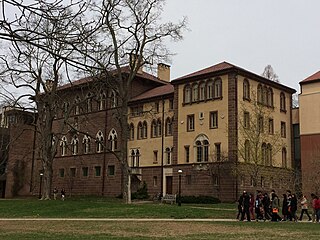
The Princeton University Art Museum (PUAM) is the Princeton University gallery of art, located in Princeton, New Jersey. With a collecting history that began in 1755, the museum was formally established in 1882, and now houses over 113,000 works of art ranging from antiquity to the contemporary period. The Princeton University Art Museum dedicates itself to supporting and enhancing the university's goals of teaching, research, and service in fields of art and culture, as well as to serving regional communities and visitors from around the world. Its collections concentrate on the Mediterranean region, Western Europe, Asia, the United States, and Latin America.

The Princeton Battlefield in Princeton, Mercer County, New Jersey, United States, is where American and British troops fought each other on January 3, 1777, in the Battle of Princeton during the American Revolutionary War. The battle ended when the British soldiers in Nassau Hall surrendered. This success, following those at the Battle of Trenton on December 26, 1776, and the Battle of the Assunpink Creek the day before, helped improve American morale.

Colymbosaurus is a genus of cryptoclidid plesiosaur from the Late Jurassic (Callovian-Tithonian) of the UK and Svalbard, Norway. There are two currently recognized species, C. megadeirus and C. svalbardensis. Both species are relatively medium-sized plesiosaurs, reaching 5 metres (16 ft) in length and 700 kilograms (1,500 lb) in body mass.

Cimoliasaurus was a plesiosaur that lived during the Late Cretaceous (Maastrichtian) of New Jersey. It grew up to 7.5 metres (25 ft) long and weighed up to 1 metric ton.

Tricleidus is an extinct genus of cryptoclidid plesiosaur known from only specimen from the middle Jurassic of United Kingdom. It was first named by Andrews in 1909 and the type species is Tricleidus seeleyi. It was a relatively medium-sized plesiosaur, measuring 5 metres (16 ft) long and weighing 700 kilograms (1,500 lb).
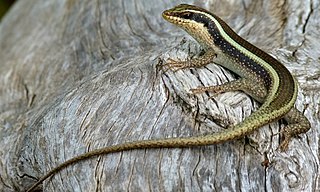
The African striped skink, commonly called the striped skink, is a species of lizard in the skink family (Scincidae). The species is widespread in East Africa and Southern Africa. It is not a close relation to the Australian striped skink, Ctenotus taeniolatus.

Anasimyia is a genus of wetland hoverflies with aquatic larvae. The genus was formerly regarded as a subgenus of the similar Lejops, and recently elevated to genus.
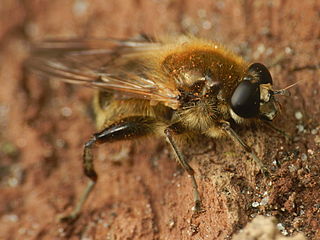
Brachypalpus is a genus of hoverflies, from the family Syrphidae, in the order Diptera. The head is triangular and produced well forwards and somewhat downwards. The thorax and abdomen with pile often rather long. The hind femur is swollen and with an obtuse spur apically and ventrally. The hind trochanters of male is spurred.
The larvae are of the rat-tailed type feeding on decaying sap under tree bark. Larvae live in decaying trees and logs. Larva and pupa have been described by Malloch.

Spinops is an extinct genus of centrosaurine ceratopsian dinosaur from the Late Cretaceous of Alberta, southern Canada. It was a medium-sized ceratopsian, reaching 4.5 metres (15 ft) in length and 1.3 metric tons in body mass.

Teuchocnemus is a genus of North American flower flies.
Chalcosyrphus (Xylotomima) anthreas, the Yellow-banded Leafwalker, is a rare species of syrphid fly found in eastern North America. Hoverflies can remain nearly motionless in flight. The adults are also known as flower flies for they are commonly found on flowers, from which they get both energy-giving nectar and protein-rich pollen.
Criorhina bubulcus'is a species of syrphid fly in the family Syrphidae.
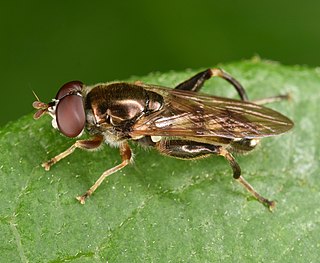
Chalcosyrphus (Xylotomima) metallicus, the Yellow-legged Leafwalker, is an uncommon species of syrphid fly observed in the southeastern United States. Hoverflies are able to remain nearly motionless while in flight. The adults are also known as flower flies for they are commonly found around and on flowers, from which they get both energy-giving nectar and protein-rich pollen.

Spilomyia alcimus, the Broad-banded Hornet Fly, is an uncommon species of syrphid fly first officially described by Walker in 1849. Hoverflies get their names from the ability to remain nearly motionless while in flight. The adults are also known as flower flies for they are commonly found around and on flowers, from which they get both energy-giving nectar and protein-rich pollen. The larvae are known as the short-tailed larvae suited for moist areas such as rot holes of trees.
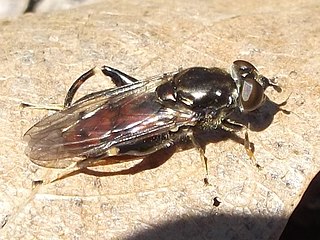
Chalcosyrphus (Xylotomima) libo, the Long-haired Leafwalker, is an uncommon species of syrphid fly observed in north-central North America. Hoverflies are able to remain nearly motionless in flight. The adults are also known as flower flies for they are commonly found around and on flowers, from which they get both energy-giving nectar and protein-rich pollen.
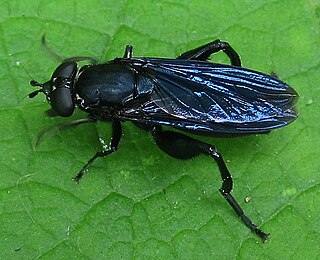
Chalcosyrphus (Xylotomima) chalybeus , the Violet Leafwalker, is a fairly common species of syrphid fly observed in the Northeastern United States. Hoverflies can remain nearly motionless in flight. The adults are also known as flower flies for they are commonly found on flowers, from which they get both energy-giving nectar and protein-rich pollen.
















